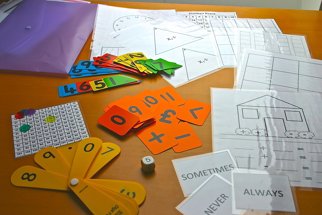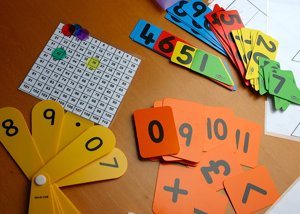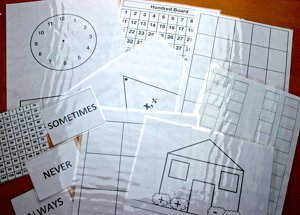Maths kits are really useful for interactive oral maths starter sessions and mental maths games. They can be used from Year 1 to Year 6 with small changes to the contents. So what are the most useful items to have?
0-9 digit cards have one set for each pupil, for more challenge limit the number of digits for an activity
Malclom Sargent school has incuded 0-20 number cards, the four operations
and other maths symbols such as a decimal point card, £, < and =
Fan numbers include one set each pupil, KS2 include a decimal point.
Fan numbers are good for showing sets of digits and multi-digit numbers, but probably
no more than 4 digits for the number so it easy to read.
no more than 4 digits for the number so it easy to read.
Arrow cards show the structure of numbers
They can show any numbers - HTU for KS1, to millions (and a decimal point) for KS2.
Arrow cards are good for place value and expanded notation, large numbers and
all number operation activities.
They can show any numbers - HTU for KS1, to millions (and a decimal point) for KS2.
Arrow cards are good for place value and expanded notation, large numbers and
all number operation activities.
Flip flops are a 16 part folded square, with images of 2s, 5s…..
These are a personal favourite – take a look at my article on these for
more details and a template.
Using Flip-Flops to practice multiplication tables
These are a personal favourite – take a look at my article on these for
more details and a template.
Using Flip-Flops to practice multiplication tables
The maths bag contents at Malcolm Sargent Primary School has a mixture of bought items and handmade laminated cards.
It is useful for each bag to have dice and counters - particularly clear counters that can be placed over numbers on a hundred square but allows the covered numbers to still be visible.
Many schools will already have most of these items - collect them together or get children to make their own.
If you are buying look for simple versions. Number fans with dots for each digit are not useful when showing 12 (it should be 10+2, not 1+2).
Remember to make a kit for your self with a large version of each item.
It is useful for each bag to have dice and counters - particularly clear counters that can be placed over numbers on a hundred square but allows the covered numbers to still be visible.
Many schools will already have most of these items - collect them together or get children to make their own.
If you are buying look for simple versions. Number fans with dots for each digit are not useful when showing 12 (it should be 10+2, not 1+2).
Remember to make a kit for your self with a large version of each item.
Related articles:
Add these to your maths kit too.
A fractions wheel and angle estimator to add to your maths kit
Another Maths Kit resource - the elastic band strip
Add these to your maths kit too.
A fractions wheel and angle estimator to add to your maths kit
Another Maths Kit resource - the elastic band strip






